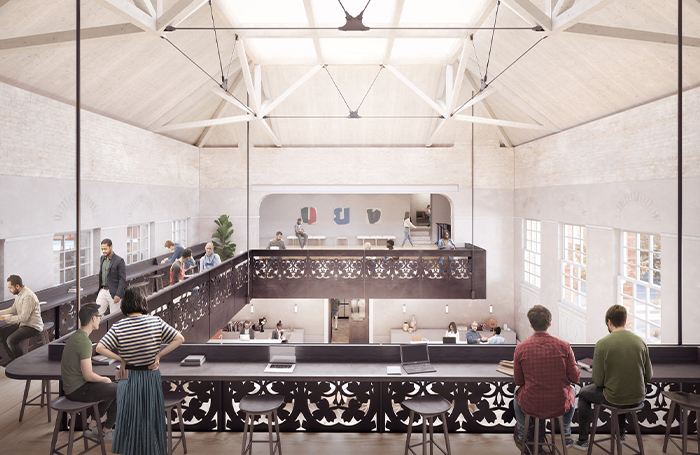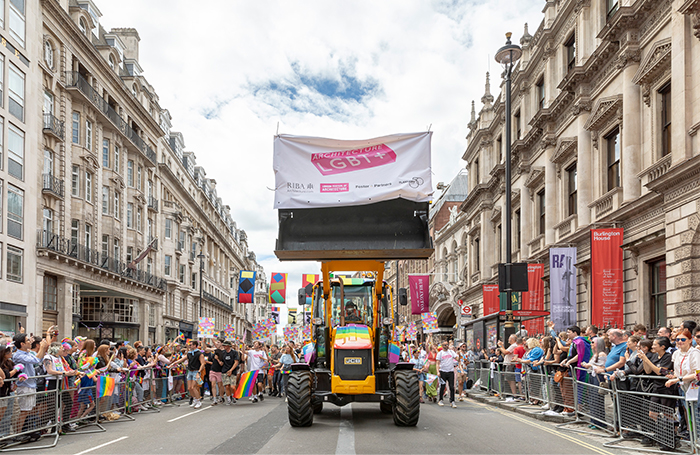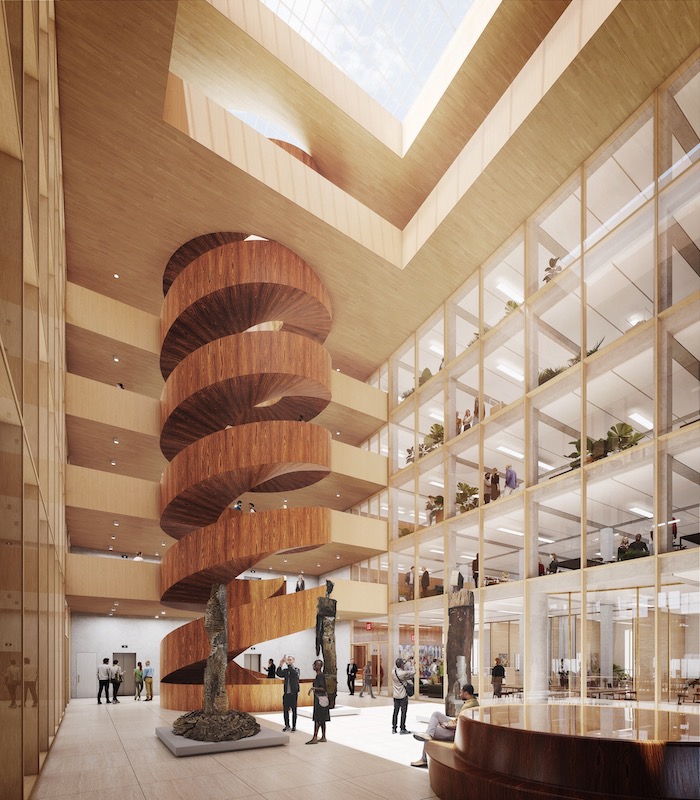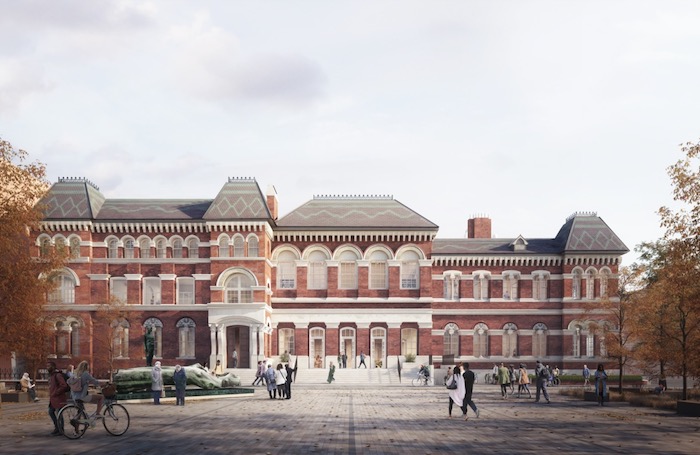Feix&Merlin is an LGBTQ+ led architecture practice, co-founded by Julia Feix and Tarek Merlin. They are excited to be RIBA London's Practice of the Month for February in particular, as it is LGBT+ History Month. It is particularly poignant this year, as for the first time ever, the number of lesbian, gay, bisexual, trans and asexual people in England and Wales has been counted in the official Census 2021.
This is important for so many reasons, not just simply for representation, but with the LGBTQ+ community now visible in data, organisations can better understand national demographics and therefore improve the lives of LGBTQ+ people with a data-based approach.
Feix&Merlin’s current projects include Walworth Town Hall, a complex retrofit of an existing Grade II listed, fire-damaged building in Southwark, with clients General Projects; and a recent competition win with David Chipperfield Architects for the LSE’s ‘Firoz Lalji Global Hub’, an extensive refurbishment and extension of an existing building on Lincoln’s Inn Fields.

What do you think is the most important issue for architects to focus on right now, and what are you doing as a practice to tackle it?
Social value. We have been lucky enough to work with some great clients who share our values, and specifically that we should look to incorporate targeted and localised social value outcomes in every project.
What does ‘social value’ look like? It's all the things that we can do and help with as architects to make our projects as welcoming and inclusive as possible; to create opportunities for local communities that surround the projects; to give a voice to local people, to create a sense of agency and a feeling of ownership, communicating, listening, talking and doing; to listen to local people and construct proposals that are tailored to local identities and needs.
More tangibly it can be specific things, for example, on our Walworth Town Hall project, an extensive community engagement process was carried out, at an early stage, which directly informed the design layout and features of the community spaces on the ground floor.
One positive outcome of the community engagement process was the setting up of a Walworth Town Hall Community Space committee, made up of members of the local community with direct responsibility and impact on the design, delivery, and operation of the community spaces.
There are many things that needed to be in place for this kind of thing to occur, starting with a progressive client, which we are very lucky to have in General Projects, political will and positivity from the local authority, Southwark, a dedicated engagement consultant, Kaizen who curated and led some great workshops and discourse, and of course the architects to collate, draw and communicate, and implement. We are very lucky that all of those aspects aligned, and very thankful to the active and engaged community who attended events, collaborated, and engaged in the processes. There are many wonderful people who live and work nearby and care deeply about this project.
In a recent conversation with a potential client, they asked us what we might offer in regards to social value, not just in general, but something specific for this particular client on this particular project. It was our very first conversation with them and we loved the client-led approach to commissioning architects on social value.
It could be about employing a young local artist or graduate to work with us on the project or commissioning a short film, or exhibition linked to the project. The point is that a certain percentage of our fee would be ringfenced specifically for creating social value.
A big part of who we are is our extracurricular initiatives, outside of projects. These include:
- mentoring roles at POC in Architecture, a mentoring scheme for people of colour in architecture
- sponsors of Open City's Accelerate programme, an education and mentoring programme that champions diversity in the built environment industry
- running Behind Closed Doors, our YouTube channel, a series of short films getting into buildings you can’t normally get into
- supporters of Architecture LGBT+, a not-for-profit grassroots organisation seeking to eliminate homophobia and transphobia in the construction industry

How do you incorporate environmental sustainability into your work?
Retrofit! “The greenest building is the one that already exists” - Carl Elefante, former president of the American Institute of Architects.
It’s so incredibly simple and yet so powerful, and like all simple and powerful statements, it's true in a very simple way. Existing buildings contain embodied energy, so if you knock them down and build new ones - the total energy of the new building is all of the previously embodied carbon, now suddenly released, plus the energy for the new construction. So, if you don’t demolish you can keep the embodied carbon neatly sequestered where it is, and if you can build any new interventions sensibly and sustainably, we can incorporate environmental sustainability into our projects.
Some may argue that a more sustainably built new building is ‘better’ than upgrading an existing building, however, a report by the US National Trust for Historic Preservation in 2016 found that "it takes between 10 and 80 years for a new building that is 30 per cent more efficient than an average-performing existing building to overcome, through efficient operations, the negative climate change impacts related to the construction process".
Reusing an existing building and upgrading it to be as efficient as possible is almost always the best choice, but some also argue that existing buildings don’t always have the right floor-to-ceiling heights for modern standards, or that some don’t have any historic or architectural merit. The answer is simply that you can modify existing buildings and add to them, bringing them up to modern standards, and making them beautiful at the same time.
For our recent competition win with David Chipperfield Architects (DCA) for the London School of Economics on the Firoz Lalji Global Hub at 35 Lincoln’s Inn Fields, the main question was to demolish or retain. The LSE asked for a world class zero carbon building, and the DCA X F&M collaboration started with the premise that we would retain and transform what is currently a fairly unremarkable building into a world class piece of sustainable architecture, rather than demolish and rebuild.
We showed that you can transform underwhelming existing spaces into spectacular ones, and that you can create ‘new’ jaw-dropping architecture out of ‘old’. We are very excited about how this project might act as an exemplary precedent.
On our Walworth Town Hall project all new structural interventions are in CLT (Cross Laminated Timber), and Glulam (Glued laminated timber). This came with an extra cost in comparison to other alternatives but yet again we are supported by a progressive client in General Projects and a supportive local authority taking a leap with us in a new contemporary vision for a beautiful heritage building.
During stage two, we thought that this would be more costly than steel, however, price fluctuations as a result of COVID-19 and Brexit meant that the QS actually thought CLT and Glulam turned out to be cheaper.
A new project we are looking at right now is the conversion of a large existing substation, on a small backland site into a new multi-unit housing project. It’s part of this same conversation about how we can take existing buildings with wildly different uses and repurpose them into new residential typologies.
One boring but absolutely fundamental point on retrofit is VAT. At the moment there is a tax incentive to demolish and rebuild, in other words, a tax penalty if you want to retain and reuse. In broad terms, 20 per cent VAT is chargeable on most forms of refurbishment and renovation and typically between 0 per cent and 5 per cent on new build construction.
This is the wrong way around and must be changed if we are to move towards a new default position of retrofit of existing buildings instead of demolition, which will help bring us all closer to carbon reduction targets. Feix&Merlin proudly support the RetroFirst campaign by the Architect’s Journal.

What benefits have you experienced from becoming a RIBA Chartered Practice?
Feix&Merlin are very proud to be a RIBA Chartered Practice and we are supported by RIBA in many different ways. For example, we attended MIPIM in 2019, which can be a bit of a minefield to navigate, and we got a lot of advice along the way as well as some all-important introductions. We are headed back this year actually so hit Tarek up if you are going to be there too!
We also make use of the legal helpline from time to time and it’s always reassuring to talk things through, realising that often the issue you thought was unique, is actually quite common and the precedents are there to discuss and chat through with a legal professional.
As an LGBTQ+ led practice, we wanted to mention the very first LGBTQ+ event at Portland Place, organised by the then RIBA President, Jane Duncan, back in the mid 2000s. It wasn’t a very big event and no great fanfare but it was an official LGBTQ+ event at RIBA and I still remember it vividly as it meant a great deal to us at the time.
Since then, there have been some even bigger and more spectacular events over the years, most notably the Architecture LGBT+ organised Pride breakfasts that RIBA kindly hosts every year. We are proud supporters of Architecture LGBT+ and excited about how RIBA and this grassroots organisation continue to collaborate in the future. We are also currently planning a special celebration of queer culture with the RIBA in collaboration with Architecture LGBT+, more on that coming very soon.
Most importantly though we are proud to be a part of RIBA’s more inclusive and welcoming approach and outlook. We want to take this opportunity to thank RIBA President Simon Alford for his disruptive energy and mission to open up RIBA’s buildings as places to collaborate and bring people together, RIBA as “the generous host”.
We look forward with great anticipation to RIBA President-Elect Muyiwa Oki taking up his position later this year, not only the first Black president of RIBA, but the youngest too. A bright fresh future for RIBA, inclusive, diverse, welcoming, and accessible.
To find out more about Feix&Merlin, visit the Feix&Merlin website or connect with them on Instagram , Twitter and LinkedIn.











